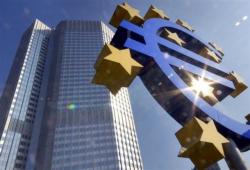The euro turns ten with the new year and the tributes are rolling out. An AP “Euro at a Glance” piece shows the vital statistics:
• The euro zone currently encompasses 15 countries with a combined population of 320 million and a 16.4 percent share of world gross domestic product.
That compares with the U.S., with a population of approximately 302 million and global GDP of 21.6 percent and China, which has a population of 1.3 billion and global share of GDP of 10.9 percent.
• Since the euro was adopted, inflation has been lower in the euro zone, dropping to around 2 percent, below the average 3.5 percent in the 1990s and far lower than the average inflation of 9.3 percent in the 1970s and 7.5 percent in the 1980s.
• More than 16 million new jobs have been created since 1999 and the unemployment rate has fallen from 9 percent in 1999 to an estimated 7 percent in 2008.
• The euro’s adoption has led to closer trade ties between the euro zone countries, too. The EU estimates that trade flow in the euro zone has increased between 5 percent and 15 percent and foreign investment has gained as much as 15 percent to 35 percent.
• The euro reached 25 percent of countries’ foreign reserves by the end of 2007, putting it second only to the U.S. dollar.
The drop in interest rates and unemployment in the Eurozone likely has very little to do with the adoption of the euro; after all, the same trends were present in the United States and the UK. But there’s little doubt that the banding together of several leading economies created a more powerful player and, certainly, one that was extremely beneficial to the smaller states that joined.
AP business writers Matt Moore and George Frey assess the twists and turns, largely favorably.
Ten years ago, Europe launched its grand experiment with a shared currency — and watched it plunge so far it needed a bailout from central banks. But as the anniversary approaches of the Jan. 1, 1999, arrival of the euro, economists say the new currency is finally fulfilling its promise as a way to lower borrowing costs, ease trade and tourism, boost growth and strengthen the European community. And doing it amid a global financial crisis that, for the moment, underlines the safety in numbers that comes from joining one, big currency. “After 10 years it has truly created a zone of security and stability,” French Finance Minister Christine Lagarde said in mid-December. “From all these points of view, the euro has in fact proven wrong the forecasts some made against the euro 10 years ago.”
When it was launched for non-cash purposes in 1999, just 11 countries were on board — Austria, Belgium, Finland, France, Germany, Ireland, Italy, Luxembourg, the Netherlands, Portugal and Spain. Notes and coins were added on Jan. 1, 2002, and the original 11 have been joined by Cyprus, Greece, Malta and Slovenia, with Slovakia slated to join on Jan. 1, bringing the total to 16. Now, some people in longtime holdouts such as Sweden and even strongly euro-skeptic Britain are beginning to reconsider the question. Smaller countries that went it alone, such as Iceland, or that haven’t met the requirements to join yet, such as Hungary, have seen their currencies collapse in value and been forced to ask the International Monetary Fund for bailouts.
Otmar Issing, a former board member of the European Central Bank, said the euro’s appeal has been its ability to provide a sense of stability and shelter from the storm of global crises. The bank, created specifically to oversee the euro, has taken a strong anti-inflationary stance that mirrors that of its chief predecessor, Germany’s Bundesbank central bank. “The euro is a stable currency, inflation expectations were under control right from the start,” Issing told The Associated Press.
The major bug is also a feature:
The chief complaints from governments during the euro’s first 10 years have arisen from the bank’s one-size-fits-all interest rate policy — which can’t give rate cuts to individual countries if their economy dips while others rise. But the credit crisis has swept over the global economy due to heavy bank losses on securities backed by U.S. mortgages to people with shaky credit has hit everyone at pretty much same time.
The UK has long been resistant to giving up its economic sovereignty and understandably so. But the ability of individual members to print more money or otherwise manipulate their currency during a crisis is what ultimately led to the doom of the euro’s predecessor, the ERM. The Eurozone puts an end to those shenanigans except in the most dire circumstances and even then requires international consensus to take drastic action. And that forces longer term thinking.
Randall Filer, a visiting professor of economics at Charles University in Prague and Hunter College in New York, said the requirement to cut government debt before joining gave political leaders the backbone to make economic reforms but place the blame on EU requirements. “It has enabled governments to embark on the labor market and fiscal reforms that were absolutely necessary,” said Filer. “The euro became “a convenient scapegoat” that enabled reforms that were needed but Europe “did not have the political will to do.”
Governments which have to stand for election in short bursts, much like corporations which rise and fall on quarterly stock reports, find it extremely difficult to pass up short term gains even at the cost of longer term benefits. Being forced to do that while able to blame a higher authority is a boon, indeed.
James Joyner is managing editor of the Atlantic Council.
Image: European-Central-Bank_0.warsawbiopic.jpg

